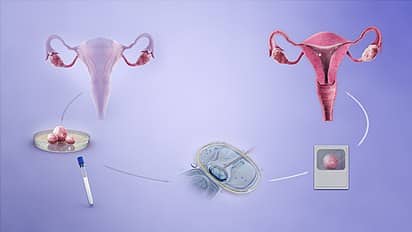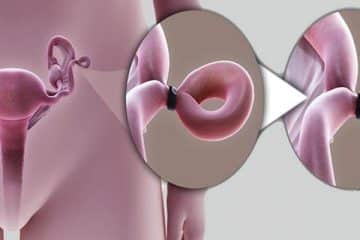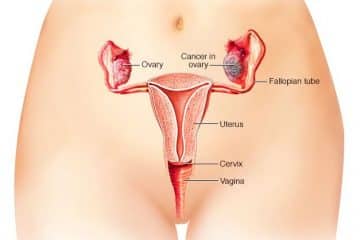In vitro Fertilisation (IVF) is a method of assisted reproduction in which a man’s sperm and a woman’s eggs are combined outside of the body in a laboratory dish. Once an embryo or embryos form, they are then placed in the uterus.
IVF is a very costly procedure and as such couples with infertility problems often seek it out when other line of treatments such as medications, surgery, etc have failed.

Reasons for In vitro Fertilisation
IVF is performed to treat infertility issues where other lines of treatment have failed. Indications of IVF include:
- Reduced fertility in women over the age of 40
- Blocked or damaged fallopian tubes
- Reduced ovarian function
- Endometriosis
- Uterine fibroids
- Male infertility, such as low sperm count or abnormalities in sperm shape
- Unexplained infertility
- Treatment of genetic disorder
More: Cesarean Delivery Side Effects
Types of In vitro Fertilisation
The three main approaches to IVF that involve no or fewer drugs are natural cycle IVF, mild stimulation IVF and in vitro maturation (IVM).
Natural cycle IVF
This type of IVF involves the use of medication to stimulate the ovaries to release several eggs for collection. The normal cycle is followed and an egg is collected during ovulation and combined with the sperm of the partner to induce fertilization.
Although this process does not have a high success rate, it does not risk ovarian hyperstimulation and is also more acceptable to certain cultures or religious groups as the excess eggs do not need to be frozen or disposed of. This process also carries only the same risk of multiple pregnancies as a natural conception does.
Mild Stimulation In-Vitro Fertilization
This procedure is similar to the standard IVF treatment except for the lower dosage of hormones used to stimulate the release of multiple eggs. The medication is administered at a lower dosage and for a shorter duration of time. This can reduce the risks of ovarian hyperstimulation syndrome in women as well. It is also useful for women who are affected by PCOS (Polycystic ovary syndrome).
The advantage of mild stimulation is that there is no necessity to suppress the natural menstrual cycle and hence there will be no side-effects that are similar to menopause symptoms. The disadvantage lies in the number of eggs obtained and hence there are only fewer embryos to choose from for implantation.
Using this procedure also offers the option of having three to four cycles within six months as the stimulation is only mild. The long wait is thus eliminated before repeating a cycle of IVF. The process is also more cost-friendly compared to the standard treatment.
In vitro maturation (IVM)
In other types of IVF, the hormone is administrated to assist the eggs mature before they are removed and fertilized. However, in IVM, the eggs are removed whilst they are yet to mature and allowed to mature in the lab. This implies there is no need to administer any hormone prior to IVF.IVM is indicated in intracytoplasmic sperm injection (ICSI), a type of fertility treatment used where there’s a male infertility factor.
In-Vitro Fertilization Success Rates
Most women typically see success rates of 20-35% per cycle, but the likelihood of getting pregnant decreases with each successive round, while the cost increases. The cumulative effect of three full cycles of IVF increases the chances of a successful pregnancy to 45-53%.
In-Vitro Fertilization Risks and Complications
Serious complications from IVF medicines and procedures are rare. As with all medical treatments, however, there are some risks. This section discusses the most common risks.
Multiple Births
The major complication of IVF is the risk of multiple births. A multiple birth is the culmination of one multiple pregnancy, wherein the mother delivers two or more offspring. Multiple births are related to increased risk of pregnancy loss, obstetrical complications, prematurity, and neonatal morbidity with the potential for long term damage.
Spread of infectious disease
There is risk of spread of infectious disease like HIV/AIDS, hepatitis B, etc with IVF.
Birth defects
A review in 2013 came to the result that infants resulting from IVF have a relative risk of birth defects compared to naturally conceived infants. Parental factors included known independent risks for birth defects such as maternal age, smoking status, etc.
Drugs side effects
- Possible side effects of injectable fertility medicines include:
- Mild bruising and soreness at the injection site (using different sites for the injections can help)
- Nausea and, occasionally, vomiting
- Temporary allergic reactions, such as skin reddening and/or itching at the injection site
- Breast tenderness and increased vaginal discharge
- Mood swings and fatigue
- Ovarian hyperstimulation syndrome (OHSS)
In-Vitro Fertilization Cost
The average cost of an IVF cycle in the U.S. is $12,400, according to the American Society of Reproductive Medicine.
This price will vary depending on location, the amount of medications required to take, the number of IVF cycles, and the amount the insurance company will pay toward the procedure.
More: Panniculectomy Surgery


